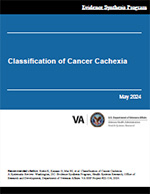
|
Recommended citation: |
Download PDF: Complete Report, Executive Summary, Report, Appendices
We identified 32 unique cancer cachexia algorithms which used over 20 different components to assess cachexia. Most algorithms described a dichotomous definition of cachexia. Based on data from 49 studies with adjusted analyses, patients with cachexia had worse survival compared to non-cachectic patients, and patients with more severe cachexia had worse survival outcomes compared to less severe cachexia. Few studies reported other outcomes of interest, including physical functioning, hospitalization, and cachexia symptom burden.
Cachexia is a progressive wasting syndrome characterized by loss of weight, muscle mass, and changes in inflammatory and metabolic processes. There are a variety of proposed algorithms to diagnosis and stage cancer cachexia, however components included in these vary, and some algorithms may not distinguish cachexia from other related conditions. Although multiple cachexia algorithms are available, the effect of these strategies on clinical and patient-important outcomes remains unclear. In this review, we synthesize the literature on existing algorithms to classify cachexia and synthesize the association between cachexia and clinical and patient-important outcomes.
We identified 114 eligible studies which described 137 (32 unique) cancer cachexia algorithms. Most studies described algorithms with a dichotomous definition of cachexia, though reported as many as 4 classification categories. The Fearon 2011 algorithm, or a modification of it, was the most frequently reported algorithm (N = 68), followed by the Cachexia Index (CXI) (N = 16), the Evans 2008 algorithm (N = 8), and the Glasgow Prognostic Score or a modification of it (N = 6). Across all studies, the 32 unique algorithms over 20 different components, such anorexia, sarcopenia, or weight loss. The cutoffs for components and definitions of cachexia varied. Forty-nine studies used adjusted analyses to report on outcomes of interest for this review. Survival was the most commonly reported outcome; other outcomes included function, hospitalization, or cachexia relevant burden, though there was sparse reporting of these outcomes. Fearon 2011, CXI, and Evans 2008 algorithms found worse survival outcomes for people with cachexia compared to those without. Among other algorithms, the majority found worse survival in cachectic compared to non-cachectic patients. Algorithms that categorized patients by severity found worse survival outcomes in those with more severe cachexia. Health systems aiming to implement an algorithm in routine practice should focus on feasibility and ease of use. Studies are needed to identify optimal cachexia algorithms and to better understand the relationship between cachexia severity and patent-important outcomes.
Classification of Cancer Cachexia: A Systematic Review (Management Brief)